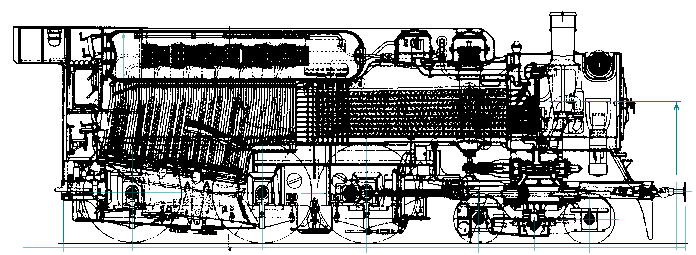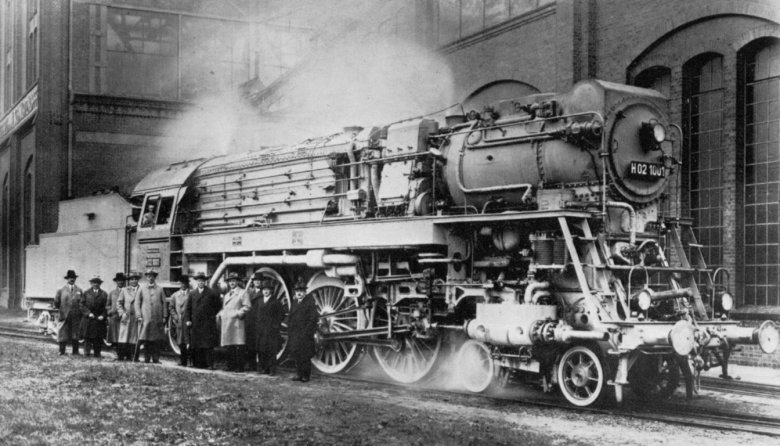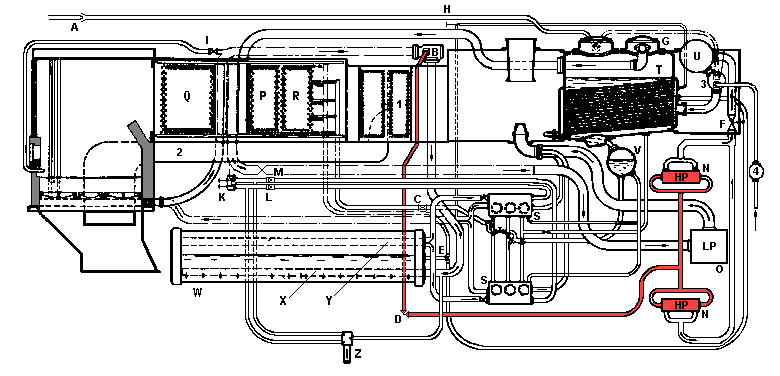A InjectorK pump lockoff valveS rotary pump1 Air preheater
B,C setback valves (?)L throttle valveT heat exchanger2 hot air duct
D HP regulatorM LP regulatorU oil separator3 LP feed heater
E changeover valveN HP cylindersV condensate reservoir4 feed pump
F security valveO LP cylinderW steam generator
G lockoff valve (?)P LP superheaterX steam introduction
H overflow valveQ HP superheaterY saturated steam withdrawal
I blowoff valveR HP feedheaterZ external steam inlet
| | | | | | | | | | | | | | | | | | | | | | | | | | | |
The plumbing of H02 was complex, and one begins to get some idea of why maintenance costs were high. Briefly, this is how it worked...
The Schmidt system avoided scaling in the HP boiler by transferring the firebox heat through a distilled-water ultra-HP circuit. The Schwarzkopff-Löffler instead used steam alone to transfer the heat; steam cannot of course deposit scale.
Saturated steam from steam generator W was pumped through the HP superheater tubes Q which lined the firebox. There it was superheated to about 900 degF and the pressure raised to 1700 psi. Only a quarter of this was fed to the HP cylinders; the rest was returned to the steam generator to evaporate more water and continue the cycle.
The HP cylinder exhaust passed through the oil separator U, the LP feed heater 3, and then the tubes of the LP boiler T; this latter is roughly equivalent to the LP boiler in the Schmidt system, but is not heated by combustion gases. Steam was raised at here 225 psi, fed to the LP superheater, and then fed via the LP regulator M to the LP cylinder. The LP exhaust feeds the blastpipe in the smokebox.
The HP exhaust condensed in the LP boiler heating tubes was pumped back to the steam generator W.
This is all very ingenious, but contains a hidden snag... it is impossible to raise steam in this loco unless you already have steam available from somewhere else. Since the firebox tubes are cooled by steam and not water, the minimum pressure in the steam generator before the fire could be lit was 70 psi. Steam could be introduced from another locomotive by via the external steam inlet Z.
Another point is that you are absolutely dependant on the steam pump to keep going. This is probably why two were fitted, but it doesn't seem to have helped reliability much.
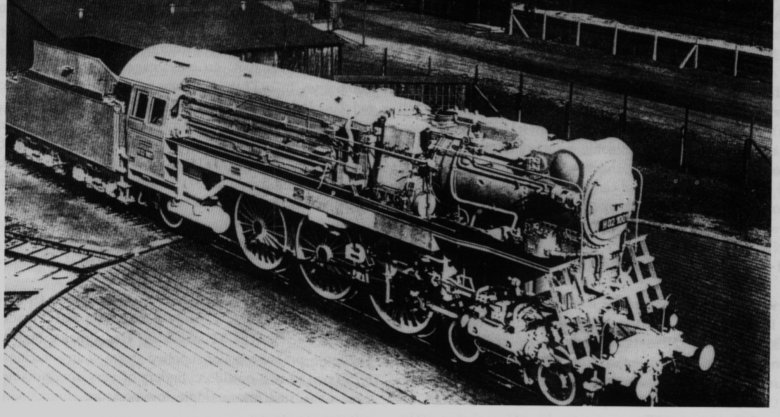
Above: H02-1001 on a turntable.
As with other high-pressure experiments, after extensive trials it was found that the increase in efficiency was small compared with the greatly increased costs. H02-1001 was also hopelessly unreliable. No more were built.
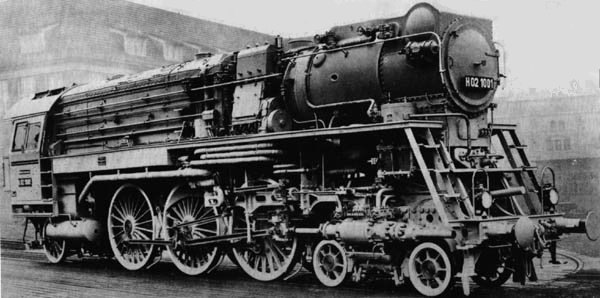 |
| H02
Left: Another view of H02, without its tender. The headlight also seems to be missing.
|
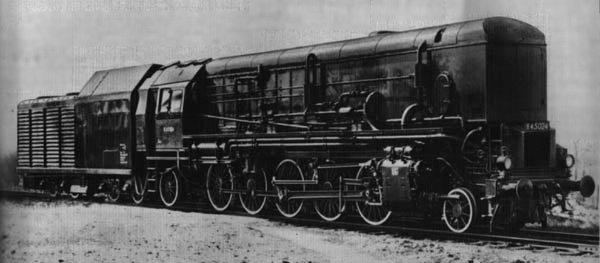 |
| H45
Left: Prototype T22571: German State Railroad class H45 024, 2-10-2.
It was built in 1951
|
This little-known design was built in 1951 in the GDR.
It had a La Mont boiler, (water-tube with pumped circulation) running at a pressure of 750 lb/sqin (42 kp/cm)
Fired by pulverised brown coal, it was intended for heavy freight trains. It made only two trial runs then was abandoned.
 |
| Left: Pictures of H45 are in short supply. This is actually a model made by Trix.
|
The H45 024 was built in 1951 by the state railways of the former German Democratic Republic (East Germany), based on a class 45 freight engine built by the Reichsbahn in 1941.
The H45 024 was fired with brown coal dust, like many engines in the GDR, and had a condensing tender. It had three cylinders, like the standard class 45, but was converted to compounding. The
inside cylinder was replaced by a HP cylinder with the reduced diameter of 400mm. LP cylinder diameter was 520mm. By the way, it really had a brown colour, like the Trix model, possibly to make leaks of coal dust less visible.
It was a total failure. Only two test runs were made, both of which had to be stopped after a few kilometres because of multiple problems, e.g. with the condenser. The costly project was then abandoned, which implies that after so little experience the problems were already considered insuperable; these could use some explanation. H45 024 was mostly scrapped in 1961.
But... parts of it are still with us, and still running, which is even more unusual. The outside cylinders, trailing wheels and the rear part of the frame were used by the GDR to convert the streamlined tank locomotive 61 002 into Pacific 18 201. This locomotive still exists and is the fastest still-operating steam engine in the world. See below:
(Info on H45 kindly provided by Fritz Gallwitz)
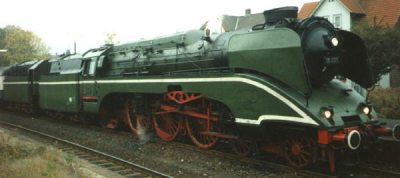 |
| Left: The 18 201 German semi-streamlined loco.
Apart from the chunks of H45 pressed into service, it used the main frame taken from the 61 002 Streamliner, and the tender from a 44 Class freight loco. The boiler was new. It is still operational in Germany, often pulling two tenders, as there are very few places in Germany to take on either fuel oil or water these days...
|
Brush up Your Locomotive German:
abblasen blow off
absperren lock off, close (valve)
Achse axle
anheizen heat up
blindwelle jackshaft
brennkammer combustion chamber
dampfeinführung steam introduction
dampfentnahme steam withdrawal
dampferzeuger steam generator
drossel throttle
entwurf draft (ie initial drawing)
feuerraumteil heating space
fremddampf foreign (ie external) steam
feuerbüchse firebox
gattung type
getriebe transmission
heizöl fuel oil
hochdruck high pressure
kessel boiler
kolbenhub piston stroke
Kuppelstange coupling rod
kurbel crank
niederdruck low pressure
oelabscheider oil separator
ofen firebox ? (lit. stove)
ölkühler oil cooler
rad wheel
regler automatic controller
rückschlagventil check valve
schmieröl lubricating oil
schnellzug express train
sicherheits safety
sicherheitsventil safety valve
speisewasser feed water
strahlpumpejet pump (injector)
überhitzer superheater
überhitzerrohe superheater tubes
überström overflow
treibraddurchmesser driving wheel diameter
ventil valve
ventile valves
verdampferrohe evaporator tubes
verdampfung evaporation
verdichter compressor
wärmeaustauscher heat exchanger
wechselventil change valve
welleshaft, axle
ä ë ö ü ß
| | | | | | | | | | | | | | | | | | | | | | | | | | | | | | | | | | | | | | | | | | | | | | | | | | | | | | | | | | | | | | | | | | | | | | | | | | | | | | | | | | | | | | | | | | | | | | |
I am no linguist. If any of this is embarrassingly wrong, please let me know.
There is a proper German-English locomotive dictionary at: http://www.frankenbahn.de/woerterbuch/woerterbuch.htm
See also: http://www.worldrailfans.org/Germany/Dictionary.shtml
Bibliography: Dampf Lok Stoffels
Typenbuch deutscher Lokomotiven. (type book of German locomotives)






